CASE STUDIES
Periorbital hyperpigmentationtreatment with topical under-eye serum (Melalumin® Under Eye Serum)
Periorbital hyperpigmentation (POH) (synonyms: under eye dark circles, lower eyelid bags, infraorbital darkening, infraorbital discoloration, periorbital melanosis and periocular hyperpigmentation), is a frequently encountered aesthetic condition in a dermatological clinic.1, 2 In the Indian setting, it has shown a prevalence of 47.7 per cent; with preponderance among women of age group 16-45-years-old.2. Although a benign disorder, it has a significant impact on Quality of Life (QoL).3 Numerous topical, physical, and surgical treatment options are available.1 Here, we present two case scenarios where topical under-eye serum (Melalumin® Under Eye Serum) was used for POH, which showed an improvement, with high patient satisfaction level.
Case 1:

Dr Farida Modi, Mumbai
A 46-year-old woman, complained of increasing undereye circles for two years. She was a desk employee at a corporate hotel. Despite make-up, she was not able to hide the under-eye circles, which was obviously affecting her confidence at desk. Her colleagues used to frequently ask her about lack of sleep and fatigue. On examination, there was periorbital hyperpigmentation (Figure 1a) around both eyelids creating a shadow effect (Grade 2). It was extending minimally over the edge of malar region. There was no presence of hyperpigmentation elsewhere on the face or neck. She gave no history of similar disorder in family nor of any chronic systemic disease.

Figure 1a: Pre-treatment

Figure 1a: Post-treatment after three months
Case 2:
Dr Rohit Batra,
New Delhi
A 51-year-old woman, complained of increasing under-eye circles for three years. She was a housewife. She also had mild hyperpigmentation on both malar regions for which she had been treated previously for nine months with topical depigmenting agents. On examination, there was periorbital hyperpigmentation; Grade 3 (Figure not available). There was mild malar hyperpigmentation (but patient was not concerned). She gave no history of any chronic systemic disease. Both the patients were treated with under-eye serum twice daily for three months, and were allowed to use only their usual cleansing products under the eyes; their usual day and night creams were allowed on the face, but not under the eyes. A broad-spectrum sunscreen was advised but also to avoid excessive exposure to sunlight.
Follow up: Monthly follow up showed improvement on dermoscopic examination. The patients too reported visible improvement by week eight. Both patients showed improvement at the end of three months. The improvement by Global Aesthetic Improvement Scale (GAIS) and satisfaction scoring for both patients are mentioned in Table 1.
Table 1: Global Aesthetic Improvement Scale and Satisfaction Scoring
Both the patients reported high level of satisfaction when measured on scale of 0-5 (0-not satisfied; 5 being very much satisfied
The treatment was continued for further three months and patients were asked to come for a follow up
Discussion
Periorbital hyperpigmentation is defined as the occurrence of bilateral hyperchromatic macules and patches usually affecting the lower eyelids; but can also be present on the upper eyelids, malar region, eyebrows, and neighboring regions.1 It is a chronic notorious distinct clinical entity, which poses a therapeutic challenge to the dermatologists and physicians. Multifactorial etiology with important causative factors being familial, post-inflammatory hyperpigmentation following atopic dermatitis, allergic contact dermatitis, lichen planus pigmentosus, erythema dyschromicum perstans, tear‐trough depression, and periorbital edema are mentioned throughout the literature.3 The pathophysiology of POH essentially revolves around an increase in melanin content while hemoglobin oxygen saturation ratio decreases locally in the POH-affected skin.1 Grading of POH5 has been shown in Table 2.
Table 2: Grades of POH 5
Based on pathogenic factors and clinical appearance, POH is classified 4 into the following four types:
1. Pigmented (appears as an infraorbital brown hue)
2. Vascular (presents as an infraorbital blue, pink, or purple hue with or without periorbital puffness)
3. Structural (appears as structural shadows of skin colour formed by facial anatomic surface contours, and may be associated with infraorbital palpebral bags, blepharoptosis, and loss of fat with bony prominence)
4. Mixed (combines two or three of the above appearances).
Pigmentation can be epidermal or dermal and Woods’s lamp examination and dermoscopy is a useful diagnostic tool.3 Topical agents known to decrease the melanin and improve the blood circulation in the periorbital region are most suitable and convenient. A topical under-eye serum comprising Aldavine 5X (1%), Tyrostat 09 (2%) and Lanachrys 2B (1%) (Melalumin® Under Eye Serum; Menarini India) has shown its effectiveness and safety in Indian patients with POH.4 This multi-ingredient topical under-eye serum has multimodal action (Figure 2). This under-eye serum has shown to stimulate the production of important structural proteins, promote collagen synthesis, maintain microcapillary integrity upon ultraviolet exposure, increase skin elasticity and resilience and reduce the appearance of dark circles.4

Fig 2: Multimodal action of Melalumin® Under Eye Serum
+In response to external aggressions such as UV, keratinocytes and fibroblasts initiate various biochemical pathways involving the upregulation of prostaglandin E2 (PGE2) and of the vascular endothelial growth factor (VEGF).Through a cascade of biochemical and cellular reactions, PGE2 and VEGF induce microcapillary dilation and permeability thereby affecting their integrity. (Data on file)
*Inhibits Tyrosinase enzyme, which is essential in melanogenesis $ Lanachrys enhances adrenaline lipolytic activity, thereby enabling fatty acid elimination.
Scientific evidence: Effectiveness of this under-eye cream was proven among Indian patients aged 18 to 55 years with Grade I to IV pigmentary POH, when used for three months. Effectiveness parameters (Global photographs assessment, colorimeter values, and dermoscopic results) is presented in Table 3.
Patient’s global satisfaction is depicted in Figure 3; about 19 per cent found the treatment to be excellent and 44.71 per cent patients found the treatment to be very good on the scale of global satisfaction. No adverse effects were noted.
In conclusion
POH is a common dermatological disorder, with numerous treatment options available. Topical under-eye serum consisting of Aldavine 5X (1%), Tyrostat 09 (2%) and Lanachrys 2B (1%) was found to be effective and safe in Indian patients with POH grade I-IV. In the above-mentioned cases, the patients were satisfied with the treatment; clinicians noted improvement with use of Melalumin® Under Eye Serum for three months.
References:
1.
Goldman,A,Goldust,M,Wollina,U.Periorbital Hyperpigmentation—Dark Circles under the Eyes;Treatment Suggestions and Combining Procedures.Cosmetics 2021,8,26.
2.
Sawant O,KhanT.Management of periorbital hyperpigmentation:An overview of nature-based agents and alternative approaches.DermatolTher.2020 Jul;33(4):e13717.doi:10.1111/dth.13717.
3.
Sarkar R,Das A.Periorbital Hyperpigmentation:What Lies Beneath? Indian Dermatol Online J.2018 Jul-Aug;9(4):229-230.
4.
Chandrshekhar BS.Soumya.S.Effectiveness and Safety ofTopical Under-eye Serum in Patients with Periorbital Hyperpigmentation:An Open-label Single Arm Prospective Study.J Clin Aesthet Dermatol.2022;15(2):18–22.
5.
Sheth PB,Shah HA,Dave JN.Periorbital hyperpigmentation:a study of its prevalence,common causative factors and its association with personal habits and other disorders.Indian J Dermatol. 2014;59(2):151-157.